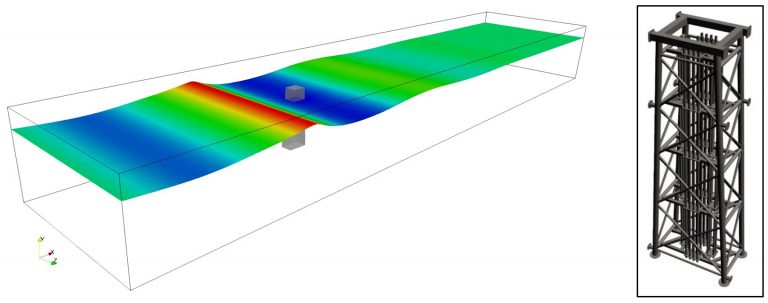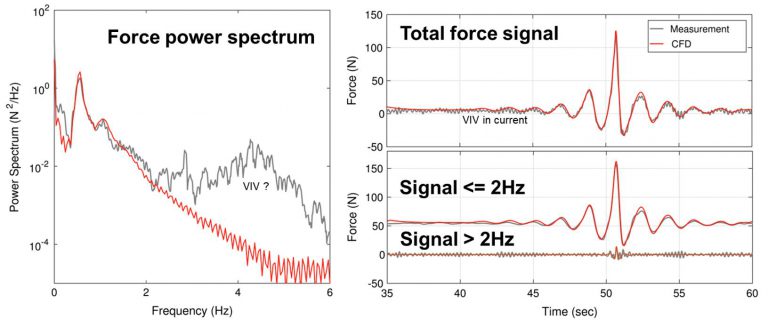EXTREME WAVE-CURRENT FORCES ON SPACE-FRAME OFFSHORE STRUCTURES
This study concerns the accurate representation of wave and current hydrodynamic forces on space-frame offshore structures, such as jackets and compliant towers, which typically comprise cylindrical members (See Figure 1). Historically, the Morison equation, which consists of a summation of drag and inertia force term, was used to estimate the total (global) forces with tunable empirical drag and inertia coefficients. Accurate estimation of global forces are important as these platforms are typically designed to withstand a storm with 10,000 year return period. The use of Morison equation is fine for waves alone. However, the presence of currents modifies the flow field as it encounters the structure acting like an obstacle array (or resistance), and this results in a global flow and the associated force reduction on the structure – a phenomenon termed current blockage. With the waves present on top of the existing current, there is an additional flow and force reduction which is now coined as wave-current blockage.
To account for the blockage effect, we use Computational Fluid Dynamics (CFD) as a numerical tool. Given the present state of technology, it is still impossible to accurately simulate the flow around a complex space-frame structure and to accurately resolve the individual wakes for every cylindrical member and the global wake for the entire structure using CFD. Therefore, we choose to simulate the global effect instead by using a porous block as a proxy to the structure, which in this case is the offshore jacket. To represent the same amount of resistance to the flow field, Morison drag and inertia stresses are embedded and distributed over the enclosed volume of the porous block. In doing so, we still require the use of Morison equation and the empirical Morison drag and inertia coefficients. This CFD-based approach has been implemented in a numerical wave tank based on the open-source software OpenFOAM and waves2foam toolbox (See Figure 1), and the simulations run on the NUS HPC clusters.

The assumption of representing the actual jacket with a porous block is based on the separation of length scales, i.e. the blockage effect is governed by global large-scale wake structure (which scales as the frontal width of the jacket). This wake structure is more dominant and hence more important than the local small-scale details of the wakes for each cylinder (which scale as the diameter of the individual cylinders). Therefore, the individual details of the cylinder are not required. Instead only the global resistance and added mass of the actual jacket needs to be represented numerically.
Whether or not this works can be seen from the recent large-scale experimental validation using a scaled North Sea jacket model tested in a large towing tank in Glasgow, UK. Figure 2 shows the comparison of the total force on the jacket due to a focussed wave group (peak frequency of 0.5 Hz) with in-line uniform current. The first plot on the force power spectrum comparison shows the importance of large-scale structures from 0 – 2 Hz, which is consistent with the drag term in the Morison equation being nonlinear – producing significant 2nd (∼1 Hz) and 3rd force harmonics (∼1.5 Hz). These large-scale structures are numerically represented by a distributed stress on the fluid as previously described. However, there is little frequency content in the CFD force spectrum beyond 2 Hz here, and this is consistent with the Morison drag form. In contrast, the experimentally measured force shows spectral contributions well above this, which consists of the small-scale wake eddies shed by the individual cylinders that may give rise to vortex-induced-vibration (VIV). The subsequent plots show the comparison of total force time histories.
The clear separation of frequency bands, here at 2 Hz, provides strong support for our separation of length scale argument for forces. Force components below 2 Hz are consistent with global Morison-type loading, while those above with individual structural element vortex shedding and subsequent interactions of the small-scale eddies.

Reference
Santo, H., Taylor, P. H., Day. A. H., Nixon. E. & Choo, Y. S., 2018. Current blockage and extreme forces on a jacket model in focussed wave groups with current. Journal of Fluids and Structures 78, 24-35.

